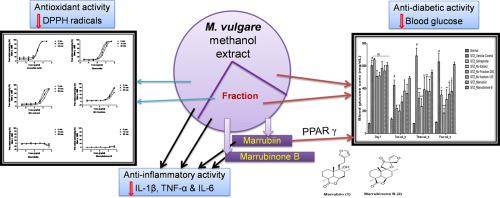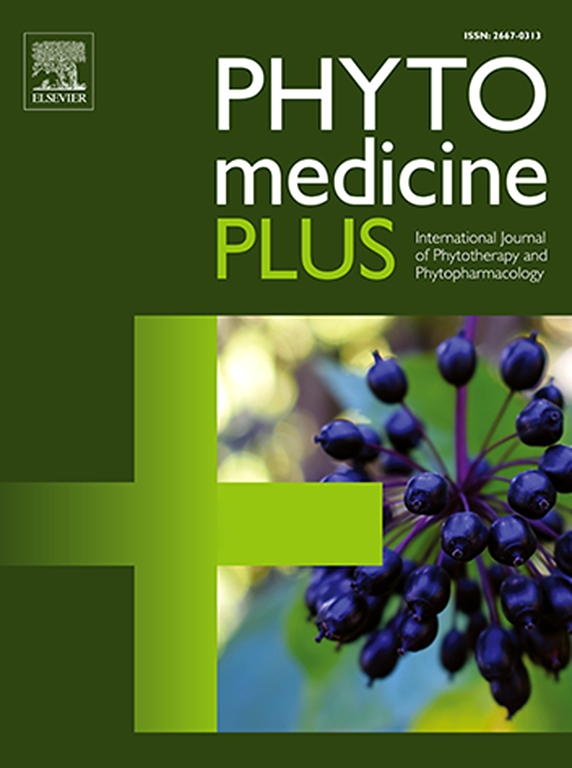Anti-diabetic and anti-inflammatory activities of Marrubiin isolated from Marrubium vulgare: Indications of its interaction with PPAR γ
Q3 Pharmacology, Toxicology and Pharmaceutics
引用次数: 0
Abstract
Background
The aerial parts of Marrubium vulgare L. were used for many ailments like catarrh to diabetes in many parts of Latin America and Asia.
Purpose
Identifying the active principle responsible for anti-diabetic activity of methanol extract of M. vulgare leaves and to predict the possible targets.
Study design
All the activity investigations were conducted simultaneously for the extract, fraction, and isolated compounds to decipher the activity profile in comparison to each other which allowed the identification of an active principle followed by use of in silico methods to identify the possible target/s.
Methods
The aerial parts of M. vulgare were extracted using methanol. A chloroform fraction was prepared. Marrubiin and marrubinone B were isolated from this fraction. The anti-hyperglycemic, hypoglycemic, and postprandial blood glucose lowering activities were investigated using streptozotocin-induced diabetic and non-diabetic rat models. Pro-inflammatory cytokine inhibitory potential was investigated using LPS induced acute-inflammatory mouse model and RAW 264.7 cells. Further, antioxidant activity was investigated using a DPPH assay. The in silico analysis, using the Swiss-target prediction tool, was carried out to predict the probable targets of the isolated molecules.
Results
Marrubiin exhibited anti-hyperglycemic effect in diabetic rats followed by hypoglycemia, and postprandial blood glucose lowering in non-diabetic rats. Methanol extract (Mv extract) and chloroform fraction (Mv fraction) showed anti-hyperglycemic and hypoglycemic effects. Moderate inhibition of IL-1β, TNF-α, and IL-6 was observed for marrubiin, marrubinone B, Mv extract, and Mv fraction, in vitro and in vivo. Neither marrubiin nor marrubinone B could quench the DPPH free radicals while Mv extract and Mv fraction could show 80 % suppression. In silico analysis has predicted that marrubiin can interact with PPAR γ but not marrubinone B.
Conclusions
Marrubiin and marrubinone B were responsible for the anti-inflammatory effect of Mv extract and Mv fraction while not contributing to the antioxidant effect. Marrubiin was found to be responsible for the anti-diabetic activity of Mv extract. The predicted interaction propensity of marrubiin with PPAR γ could explain its dual activity observed in the experimental setup.

从大叶黄杨中分离出的大叶黄杨素具有抗糖尿病和抗炎活性:与 PPAR γ 相互作用的迹象
背景在拉丁美洲和亚洲的许多地区,马鲁巴叶(Marrubium vulgare L.)的气生部分被用于治疗许多疾病,如白喉和糖尿病。目的确定马鲁巴叶甲醇提取物中具有抗糖尿病活性的活性成分,并预测可能的靶点。研究设计同时对提取物、馏分和分离出的化合物进行所有活性研究,以便在相互比较的基础上解读活性特征,从而确定活性原理,然后使用硅学方法确定可能的靶标。制备了氯仿馏分。从该馏分中分离出 marrubiin 和 marrubinone B。利用链脲佐菌素诱导的糖尿病和非糖尿病大鼠模型,研究了其抗高血糖、降血糖和餐后降血糖活性。使用 LPS 诱导的急性炎症小鼠模型和 RAW 264.7 细胞研究了抑制前炎症细胞因子的潜力。此外,还使用 DPPH 法研究了抗氧化活性。使用 Swiss-target 预测工具进行了硅学分析,以预测分离分子的可能靶点。结果马鲁比邻对糖尿病大鼠表现出抗高血糖作用,随后出现低血糖,并降低了非糖尿病大鼠的餐后血糖。甲醇提取物(Mv 提取物)和氯仿馏分(Mv 馏分)具有抗高血糖和降血糖作用。在体外和体内,观察到 marrubiin、marrubinone B、Mv 提取物和 Mv 部分对 IL-1β、TNF-α 和 IL-6 有适度的抑制作用。marrubiin 和 marrubinone B 都不能淬灭 DPPH 自由基,而 Mv 提取物和 Mv 部分的抑制率为 80%。结论 marrubiin 和 marrubinone B 是 Mv 提取物和 Mv 部分抗炎作用的主要成分,但对抗氧化作用没有贡献。研究发现,马鲁宾对 Mv 提取物的抗糖尿病活性起作用。预计 marrubiin 与 PPAR γ 的相互作用倾向可以解释在实验装置中观察到的其双重活性。
本文章由计算机程序翻译,如有差异,请以英文原文为准。
求助全文
约1分钟内获得全文
求助全文
来源期刊

Phytomedicine Plus
Medicine-Complementary and Alternative Medicine
CiteScore
3.70
自引率
0.00%
发文量
178
审稿时长
81 days
期刊介绍:
 求助内容:
求助内容: 应助结果提醒方式:
应助结果提醒方式:


